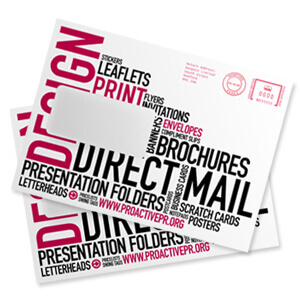 1) Wallet or pocket?
1) Wallet or pocket?
All envelopes are split into either wallets or pockets. Put simply, wallets open on the long edge and pockets on the short edge.
2) What size?
Envelopes are measured in ‘C’ sizes that correspond to the standard ‘A’ sizes for paper. So a C5 envelope would hold A5 paper and so on. The anomaly to this is a DL envelope, which holds 1/3 A4 (so an A4 sheet folded into thirds, or a compliment slip). The most common standard sizes for envelopes are below:
C3 – 458 x 324mm
C4 – 324 x 229mm
C5 – 229 x 162mm
C6 – 162 x 114mm
DL – 110 x 220mm
3) Windows.
Fairly straightforward this one, but most envelopes are available with or without a window. Think how you plan to use the envelopes – will you always have an address to show through? NEVER place an address sticker over the window – it creates a bad impression from the outset. Often it’s the case that you will need both – printing these at the same time will significantly save on costs.
4) Paper.
All too often people do not consider the material that their envelopes are made from. If you’re promoting a premium product or brand, then lightweight envelopes will create the wrong impression. Remember that the envelope is the first thing the recipient will see (and feel). By the same token, if you’re printing envelopes as part of a large mailing project then keeping the weight down may be vital – it could save a small fortune in postage costs.
5) Machine mailing.
If your envelopes are to be used for a direct mail campaign, it is essential that you speak with the direct mail company before having your envelopes printed. Only certain specifications of envelopes are ‘machinable’ – the restrictions are usually in size, whether they are wallet or pocket and the weight of material. It will depend on what machines the direct mail company is using as to what specification of envelopes they can use. It could be a costly mistake to print many thousands of envelopes, only to find they are not suitable to be used in a direct mail campaign (or may cost much more to do so).
6) Colours.
Generally envelopes are either printed in CMYK (full colour), or between 1 and 4 spot colours (Pantones). The more colours you use, the more expensive they are. Remember that black counts as a separate colour, so if your logo is blue but the return address is black, we will print in 2 colours.
7) All over print?
Most of the time envelopes come from stock, ready made up, and are over printed with a logo, return address and whatever else. This is the cheaper and more efficient method, but has some key restrictions. You need to leave a strip along both edges for the machine to ‘grip’ the envelope, and space around the window. It is not possible to over-print all over (or inside) the envelope. To do this, the envelopes are printed flat then assembled. This is usually only suitable for larger runs due to the costs involved, but it is possible to produce any quantity if required.
8) Non standard & custom sizes.
Whilst the ‘C’ and DL sizes are the most common, there is also a wealth of choice for other sized stock envelopes. If you have a bespoke requirement, speak to your envelope supplier to see what might be available (remember to consider the points raised above at the same time). If they don’t have quite what you’re after, then similar to ‘all over print’, you can have bespoke envelopes made up from scratch.
9) Postage regulations.
This brings us on to postage regulations. For the UK, standard post items are split in to ‘letter’, ‘large letter’ and ‘packet’. To qualify as a letter, the item must be equal to or smaller than 240 x 165 x 5mm and weigh less than 100g. For larger letter, the dimensions are 353 x 250 x 25mm and weight less than 750g. Anything bigger or heavier is a packet. Try and keep to the smallest/lightest option you can to keep postage costs to a minimum – equally, if you’ve paid for the postage, you may as well use it… so if (for example) your mailing pack weighs 55g, there’s an extra 44g you can send without incurring any additional postage costs. What else could you include in your mailing pack to increase sales?
10) PPI.
PPI stands for Printed Postage Impressions. This is a service you can set up with Royal Mail whereby your postage is printed directly on your envelopes – no need for stamps or franking. Details can be found on Royal Mail’s website here.
Once set up, the PPI can be printed at the same time as your logo and return address, ultimately saving time and money when used in the office.
11) Alternatives…?
If you have doubts over whether printed envelopes are quite right for you, then are alternatives. Maybe you send out all different sizes of mail, or padded envelopes which are tricky to overprint. In this instance, we would recommend pre-printing label sheets. You could print your logo and return address onto A4 sheets of labels. These can then be over-printed with the recipient’s address as and when required, stuck on to a standard plain envelope and you end up with a similar result. Label sheets come in a multitude of shapes and sizes, although you’ll probably want to stick to A4 sheets so they run smoothly on your office printer. You can choose from a range of stock items for the size of the labels and number per sheet.
